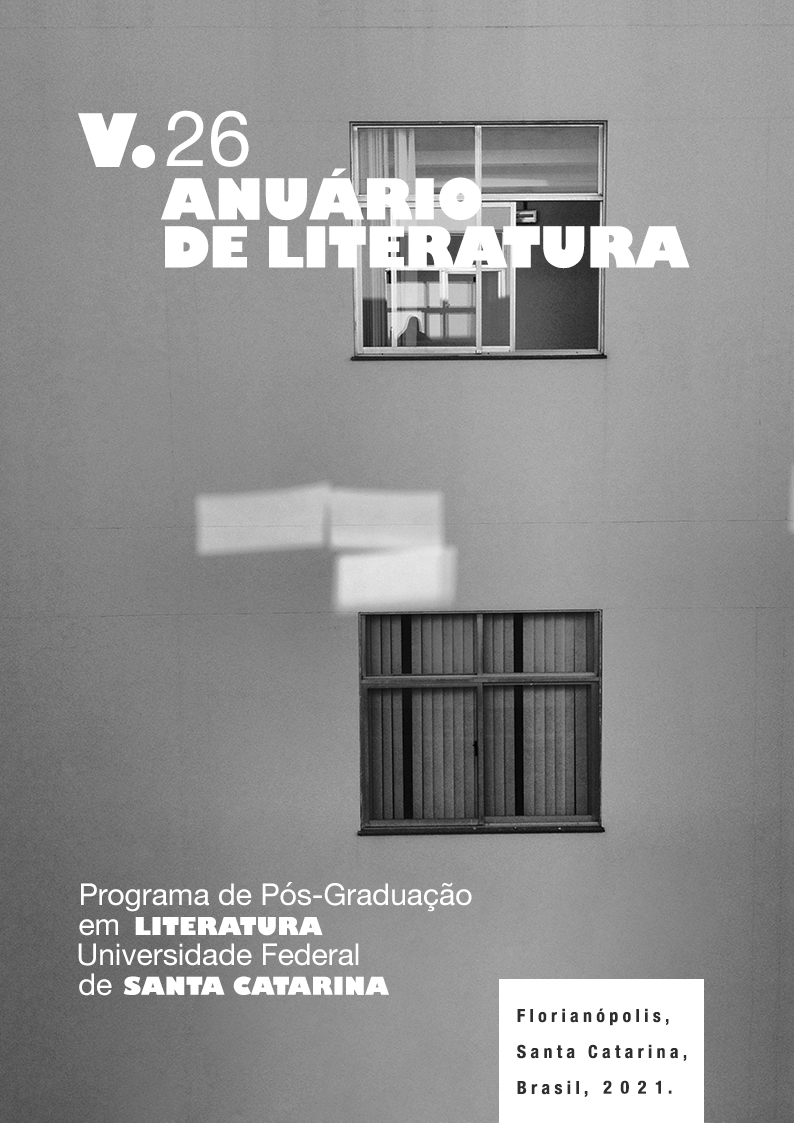O território da velhice em Dalton Trevisan
DOI:
https://doi.org/10.5007/2175-7917.2021.e77993Resumen
A partir do final da década de 1940 do século XX, a prosa moderna brasileira foi impulsionada por um grupo de escritores que começava a definir o núcleo da ficção curta urbana. Como fruto desse momento, o conto se firma e amplia seus universos conteudísticos, visitando desde temáticas urbanas até os temas regionalistas, do relato documental às investidas intimistas. Dentre as temáticas urbanas e coletivas destacamos a velhice. Essa temática está presente nas narrativas de vários representantes da linha média que caracterizou a ficção brasileira dos anos de 1950 até essas primeiras décadas do século XXI. Das trinta histórias que constituem A guerra conjugal (1969) do contista curitibano Dalton Trevisan, algumas trazem protagonistas na velhice, expondo-as em uma fase do casamento na qual a solidão se instala incisiva e seca. Se em outras narrativas o malogro do casamento é espicaçado pelas ironias constantes, nos enredos em que a velhice é temática central o silêncio predomina como significado maior do distanciamento dos casais. Em "Batalha de bilhetes", a temática da velhice é problematizada através dos personagens protagonistas João e Maria. O conto joga alternadamente com a voz do narrador, que introduz o cenário e descreve as ações das personagens; com o diálogo entre eles, curto e estéril, sugerindo a falta de comunicação; e com a linguagem dos bilhetes, elemento primordial para nossos comentários e, como o próprio título incita, "instrumento bélico" usado pelos personagens. Neste artigo procuramos analisar as marcas que diferenciam as perspectivas adotadas e como a distância do discurso constrói a imagem da velhice isolada do casal. Para a leitura utilizaremos Bosi (1988) sobre a velhice e na análise do plano do enunciado e do plano da enunciação.
Citas
ALVES, Castro. Espumas flutuantes. In: ALVES, Castro. Poesias Completas. São Paulo: Ediouro, 1997.
BEAUVOIR, Simone. A velhice. 3. ed. Trad. de Maria Helena F. Monteiro. Rio de Janeiro: Nova Fronteira,1990.
BOSI, Alfredo. O conto brasileiro contemporâneo. 8. ed. São Paulo: Cultrix. 1988.
CANDIDO, Antonio. A educação pela noite e outros ensaios. São Paulo: Ática, 1989.
CARLOS, Teresinha. Narrador enquanto linguagem e as linguagens do narrador: o procedimento técnico-narrativo no conto “Uma vela para Dario” de Dalton Trevisan. In: RAMALHO DE FARIA, Sônia. Literatura e Cultura: tradição e modernidade. João Pessoa: Idéia/Editora Universitária UFPB, 1997, p. 137-154.
CARPEAUX, Otto Maria. Pretensão sem surpresa. In: CARPEAUX, Otto Maria. Livros sobre a mesa: estudos de crítica. Rio de Janeiro: Livraria São José, 1960, p. 250-255.
CHAUÍ, Marilena. Janelas da alma, espelho do mundo. In: NOVAES, Adauto (Org.) O Olhar. São Paulo: Companhia das Letras, 1995, p. 31-63.
CHEVALIER, Jean; GHEERBRANT, Alain. Dicionário de símbolos. 10. ed. Trad. de Vera da Costa e Silva et al. Rio de Janeiro: José Olympio, 1996.
COMITTI, Leopoldo. Anjo mutante – o espaço urbano na obra de Dalton Trevisan. Literatura e Sociedade, v. 1, n. 1, p. 81-87, 1996.
DAMASCENO, Luciana Martins. A estética da crueldade em Dalton Trevisan.. Dissertação (Mestrado em Literatura) – Departamento de Teoria Literária e Literaturas, Universidade de Brasília, Brasilia, 1993.
FERREIRA, Maria Letícia. O retrato de si. LEAL, Ondina Fachel (Org). Corpo e significado. Porto Alegre: Editora da UFRS, 1995, p. 419-429.
GOMES, Álvaro Cardoso; VECHI, Carlos Alberto. Literatura Comentada: Dalton Trevisan. São Paulo: Abril, 1981.
HOHLFELD, Antônio. O conto de costumes. In: HOHLFELD, Antônio. Conto brasileiro contemporâneo. 2. ed. Porto Alegre: Mercado Aberto, 1988, p. 160-165.
JOSEF, Bella. O conto brasileiro contemporâneo: transgressão e metamorfose. In: HOUAISS, Antônio et al. Estudos universitários de língua e literatura. Rio de Janeiro: Tempo Brasileiro, 1993, p.109-118.
LIMA, Alceu Amoroso. Idade, sexo e tempo. Rio de Janeiro: Agir, 1962.
LUCAS, Fábio. A face visível. Rio de Janeiro: José Olympio, 1973.
SOBANIA, João Correa. O Personagem idoso e a sexualidade na obra de Dalton Trevisan: momentos finais de um tenso itinerário machista. 1994. Dissertação (Mestrado em Literatura Brasileira) – Departamento de Linguística, Letras Clássicas e Vernáculas, Universidade Federal do Paraná, Curitiba, 1994.
TREVISAN, Dalton. O Vampiro de Curitiba. São Paulo: Record, 1979.
TREVISAN, Dalton. A guerra conjugal. Rio de Janeiro: Civilização Brasileira, 1969.
TREVISAN, Dalton. A guerra conjugal. 9. ed. rev. Rio de Janeiro: Civilização Brasileira, 1987.
WALDMAN, Berta. Do Vampiro ao cafajeste. São Paulo: Hucitec, 1982.
Descargas
Publicado
Cómo citar
Número
Sección
Licencia
Derechos de autor 2021 Márcia Tavares

Esta obra está bajo una licencia internacional Creative Commons Atribución 4.0.

Este trabalho está licenciado com uma Licença Creative Commons - Atribuição 4.0 Internacional.


